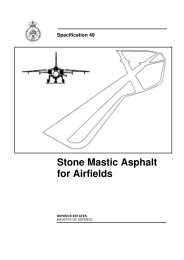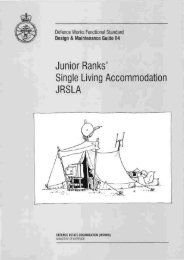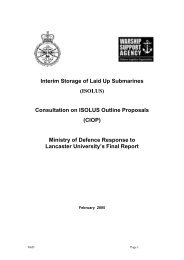Part III - Historical Survey of the Porton Down Service Volunteer ...
Part III - Historical Survey of the Porton Down Service Volunteer ...
Part III - Historical Survey of the Porton Down Service Volunteer ...
Create successful ePaper yourself
Turn your PDF publications into a flip-book with our unique Google optimized e-Paper software.
<strong>the</strong> study was carried out in 1973. If a National <strong>Service</strong>man had left <strong>the</strong> <strong>Service</strong>s in, for<br />
example, 1955, only his medical history to that date was considered in this follow-up study.<br />
Indeed, <strong>the</strong> average length <strong>of</strong> <strong>Service</strong> after <strong>the</strong> volunteers had visited <strong>Porton</strong> was about 4<br />
years, and varied between 4 months and 10 years.<br />
The points made were as follows [113]:<br />
• no significant difference was found in <strong>the</strong> instances <strong>of</strong> illness experienced by <strong>the</strong><br />
men exposed to GB and those not exposed, after <strong>the</strong>y had been to <strong>Porton</strong>;<br />
• <strong>the</strong>re was no significant difference in <strong>the</strong> sicknesses experienced by men<br />
exposed to GB before and after <strong>the</strong>ir visit to <strong>Porton</strong>;<br />
• no incidents <strong>of</strong> psychiatric illness were recorded among <strong>the</strong> 37 men who had<br />
been exposed to GB. One man was invalided for psychiatric reasons from <strong>the</strong><br />
group who had not been exposed.<br />
The conclusion drawn was that <strong>the</strong>re was no evidence that exposure to GB at <strong>Porton</strong> had any<br />
adverse effect upon health, psychiatric or o<strong>the</strong>rwise, <strong>of</strong> <strong>the</strong> volunteers exposed to GB<br />
considered by this follow-up study.<br />
A third follow-up study was conducted which analysed medical records <strong>of</strong> volunteers who<br />
attended <strong>Porton</strong> between March 1975 and Feb 1980 [114]. Sixty volunteers were chosen for<br />
<strong>the</strong> study: 30 who had not been exposed to GB during <strong>the</strong>ir stay and 30 who had (some <strong>of</strong><br />
<strong>the</strong>se took part in studies <strong>of</strong> nerve agent treatments during which <strong>the</strong>y were exposed to GB,<br />
and some were partially protected when <strong>the</strong>y were exposed). Medical records for three <strong>of</strong> <strong>the</strong><br />
men could not be traced from <strong>Service</strong> sources and <strong>the</strong>refore 57 volunteers' medical records<br />
were analysed (29 had been exposed to GB). <strong>Service</strong> medical records were used, covering<br />
<strong>the</strong> period up to <strong>the</strong> end <strong>of</strong> October 1988, when <strong>the</strong> study was conducted, or up to <strong>the</strong><br />
volunteer's discharge from service. The average length <strong>of</strong> service since a volunteer had<br />
attended <strong>Porton</strong> was around 80 months; 24 <strong>of</strong> <strong>the</strong> 57 volunteers considered were still serving<br />
at <strong>the</strong> time <strong>of</strong> <strong>the</strong> study.<br />
The medical incidences (measured per 1000 man months) for <strong>the</strong> two groups were compared<br />
and <strong>the</strong> observations are summarised in Table 9.3.<br />
Medical Incident Group exposed to GB Group not exposed to GB<br />
Pre-<strong>Porton</strong> Post-<strong>Porton</strong> Pre-<strong>Porton</strong> Post-<strong>Porton</strong><br />
Admission to hospital, sick<br />
bay, station sick quarters<br />
17.4 9.5 9.1 8.2<br />
Out patient referrals for<br />
specialist consultation<br />
8.7 4.7 7.3 6.1<br />
Days lost through sickness<br />
133.3 109.6 147.7 73.5<br />
Table 9.3. Medical incidences in third follow-up study<br />
The incidences were not significantly different between groups, nor within groups before or<br />
after <strong>the</strong> men had attended <strong>Porton</strong>. The causes <strong>of</strong> illness were also analysed and no<br />
significant differences were found. There were no cases, in <strong>the</strong> records used in this study, <strong>of</strong><br />
psychiatric invaliding. The conclusion made was that <strong>the</strong>re was "no evidence from this study<br />
that <strong>the</strong> exposure <strong>of</strong> volunteers to low doses <strong>of</strong> nerve agents results in any adverse medical<br />
sequelae" [114].<br />
9.6.3. Detachment <strong>of</strong> <strong>the</strong> retina<br />
In January 1982 [99] <strong>the</strong> Institute <strong>of</strong> Aviation Medicine (IAM) suggested <strong>Porton</strong> should adopt<br />
more stringent standards for volunteers used in miosis studies. IAM was concerned that<br />
short-sighted people (myopes) might suffer a detachment <strong>of</strong> <strong>the</strong> retina if <strong>the</strong>y were exposed<br />
to GB. GB could induce spasms in <strong>the</strong> ciliary muscles <strong>of</strong> <strong>the</strong> eye (<strong>the</strong> ciliary muscles form a<br />
90









